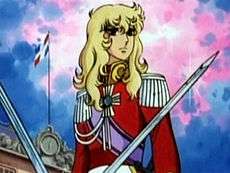Oscar François de Jarjayes
Brigadier Oscar François de Jarjayes (オスカル・フランソワ・ド・ジャルジェ, Osukaru Furansowa do Jaruje) is a supporting character in the manga series The Rose of Versailles, created by Riyoko Ikeda, while in the anime is the main protagonist.
| Oscar François de Jarjayes | |
|---|---|
 | |
| First appearance | Oscar, the destiny of a rose |
| Last appearance | Adieu, My Beloved Oscar |
| Created by | Riyoko Ikeda |
| Portrayed by | (see below) |
| In-universe information | |
| Alias | Lady Oscar |
| Gender | Female |
| Title | Brigadier (current) Colonel, Commander (former) |
| Occupation | Commander of the Royal Guard Commander of the Military Regiment B |
| Family | Jarjayes |
| Spouse | André Grandier |
| Relatives | Parents
Sisters
Other:
|
Character history
Born the last of five daughters to the Commander of the Royal Guards, General François Augustin Regnier de Jarjayes (a real historical personage[1]), she is raised by her father as if she were a boy in order to take his place and command the Royal Guards serving at Court after he retires. At the age of fourteen, as soon as her training in the basic military skills is complete, Oscar is given the task to protect the Dauphine Marie Antoinette when she arrives at the French Court.
Despite being raised as if she were a boy and dressing in males' clothes, Oscar is open about being female.[2] Even as she embraces her womanhood, she uses her male position to gain freedoms that she could never have as a lady of the court.[3]
She is the love interest of both André Grandier, her servant at the Jarjayes mansion and afterwards a soldier in her regiment, and Marie Antoinette, who she acts as a bodyguard to.[4] She also earns the admiration and love of Rosalie Lamorlière[5], and in turn calls Rosalie her "spring breeze".[3] Other women are infatuated with Oscar, even after she tells them she is female.[6] She dislikes the court intrigues, but remains there out of loyalty to her father and her friend, Marie Antoinette. At one point, Oscar falls in love with Fersen, who has a forbidden love for Marie Antoinette.[7]
Soon gaining the Dauphine and Queen-to-be's affection and trust, Oscar experiences life at Versailles and the pain caused by the contradictions of her being a woman whom everybody, including herself, considers a man. Later in the story, Oscar learns of the political ideals of the Revolution and that the royalist regime is corrupt.[5] As the French Revolution is about to begin, Oscar refuses to sedate tumults occurring in Paris. She renounces her status and her regiment joins forces with the people marching to the Bastille. Shot by royal soldiers inside the fortress, she dies right before the prison falls.
Development

Modeled after the revolutionary Pierre-Augustin Hulin, Oscar was originally a supporting character to Marie Antoinette, and was created as a female because Ikeda was unsure if she could accurately portray a male soldier. Oscar eclipsed Marie Antoinette in popularity and due to reader feedback became a very important character only until her death.[8] Eri Izawa suggests that as Oscar is fictional, Ikeda could be freer in the portrayal of Oscar's life than Ikeda could be in the life of Marie-Antoinette, who had to die on the guillotine.[3] Oscar's androgynous persona is based on the actresses who play male roles in the Takarazuka Revue and Princess Sapphire,[9][10] and she was named for Oscar Wilde, as Ikeda is a fan of his.[11] The way Oscar is drawn has been regarded as a way of showing her androgyny: she is shorter than male characters, but taller than female characters, and her eyebrows are thicker than female characters but thinner than male characters - giving the effect of looking feminine when compared to male characters and masculine when compared to female characters.[12]
The Digimon Leopardmon's original design was based on Oscar.[13]
Actresses

In the Takarazuka Revue performances of The Rose of Versailles, Oscar has been played by several male-role actresses from 1974 to the present day.[10][14] In the 1974 Moon Troupe performance, Yuri Haruna played Oscar.[10] Mayo Suzukaze has played Oscar. Kei Aran and Hikaru Asami played Oscar in 2006.[15][16]
In the 1979 anime adaptation of The Rose of Versailles, Oscar was voiced by Reiko Tajima.[17]
In the 1979 film Lady Oscar, Oscar was played when a child by Patsy Kensit, and when adult by Catriona MacColl. MacColl's feminine and weak portrayal of Oscar was criticised, and it was felt that she was not androgynous enough to play Oscar.[18]
Reception
Oscar has been described as "iconic",[9] as an archetype,[19] "thrilling", and credited with the success of Rose of Versailles,[20] as she illustrates the performative nature of gender.[10] Ian Buruma and Deborah Shamoon consider that Oscar's politics are less important to the audience than her romances.[5][21] Shamoon sees the Oscar-Andre relationship as very different from the Cinderella-Prince Charming stories which "dominated" shōjo manga in the 1960s, where the female protagonist would lose her identity to her boyfriend. Shamoon considers that the Oscar-Andre relationship follows the pattern of pre-war douseiai shōjo novels, which featured same-sex love between girls.[22]
Kazuko Suzuki says that after RoV, "several works" were created with "nonsexual" female protagonists like Oscar, who realise their "womanness" upon falling in love.[23] Suzuki sees her as being a transitional figure between the heterosexual romances of 1960s shōjo manga and those of shōnen-ai.[24] Oscar's "gorgeous androgyny" has led to her being interpreted as belonging to the bishōnen - beautiful young men.[25]
Oscar's relationship with Andre has been interpreted as being male-male,[26] and Andre vows to die for Oscar if he needs to, like the Kabuki samurai.[21] Oscar's conflict between her principles and her loyalty to Marie-Antoinette has also been compared with a "samurai who must be faithful to an unworthy master".[19] Oscar has appeared in the Animage top 50 character list as recently as 1992.[27]
Susan J. Napier described Oscar as a "truly complex and three-dimensional figure who offered young Japanese women a different kind of role model", citing her influence in Utena Tenjo of Revolutionary Girl Utena.[28]
In 2007, a manga series called Shōjo Manga (series) was serialised in Chorus and was compiled into one volume. It told the story of an office lady who is inspired by the character of Oscar to defy her managers. It was adapted into a six episode TV series and renamed Haken no Oscar ~"Shōjo Manga" ni Ai o Komete, which aired starting from 28 August 2009.[29] In the 1990s and 2000s, Oscar inspired Revolutionary Girl Utena and Le Chevalier D'Eon.[30][31]
Anne Duggan describes Oscar as a "maiden warrior", a young woman who disguises herself as a man to take up arms and protect king and country, as in The Ballad of Mulan, Madame d'Aulnoy's Belle-Belle ou Le Chevalier Fortuné, or Marie-Jeanne L'Héritier's Marmoisan ou La Fille en garçon. At the close of the tale, the typical maiden warrior hangs up her sword. Duggan describes Oscar as a case where the maiden refuses to put away her sword, and fights against the order that she was supposed to defend. Oscar's masculinity is central to her character, unlike in the earlier maiden warrior tales, and Oscar also helps usher in a permanent change to French society by supporting the French Revolution.[32]
In Lupin III
Oscar makes a crossover appearance in the Lupin III Part II anime series episode "Versailles Burned with Love", and the series is mentioned as a frame of reference for the Rose Knights in the light novel series Gate: Jieitai Kano Chi nite, Kaku Tatakaeri.
References
- da Silva, Valéria Fernandes (2007) Mangá feminino, Revolução Francesa e feminismo: um olhar sobre a Rosa de Versalhes Archived 6 October 2008 at the Wayback Machine (in Portuguese)
- Corson, Susanne. "Yuricon Celebrates Lesbian Anime and Manga". AfterEllen.com. Archived from the original on 25 February 2008.
- Iwasa, Eri. "Rose of Versailles". ex.org. Archived from the original on 11 May 2008. Retrieved 16 February 2008.
- Thorn, Matt. "Unlikely Explorers-Gender and Sexuality in Shoujo Manga". Archived from the original on 12 February 2008.
- Shamoon, Deborah (2007). "Revolutionary Romance: The Rose of Versailles and the Transformation of Shōjo Manga". In Lunning, Frenchy (ed.). Networks of Desire. Mechademia. 2. University of Minnesota Press. p. 10. ISBN 978-0-8166-5266-2.
- Women-loving Women in Modern Japan, by Erin Subramian
- McCarthy, Helen (1 January 2006). 500 Manga Heroes and Villains. Barron's Educational Series. pp. 108–109. ISBN 978-0-7641-3201-8.
- Shamoon, Deborah (2007). "Revolutionary Romance: The Rose of Versailles and the Transformation of Shōjo Manga". In Lunning, Frenchy (ed.). Networks of Desire. Mechademia. 2. University of Minnesota Press. p. 8. ISBN 978-0-8166-5266-2.
- Welker, James (2006). "Beautiful, Borrowed, and Bent: "Boys' Love" as Girls' Love in Shōjo Manga". Signs: Journal of Women in Culture and Society. 31 (3): 847. doi:10.1086/498987.
- Robertson, Jennifer Ellen (1998). Takarazuka: Sexual Politics and Popular Culture in Modern Japan. Berkeley and Los Angeles, California: University of California Press. pp. 74–76. ISBN 0-520-21150-2.
- Graham, Miyako (1997). "Lady Oscar & I". Protoculture Addicts (45): 41.
- Anan, Nobuko (February 2014). "The Rose of Versailles: Women and Revolution in Girls' Manga and the Socialist Movement in Japan" (PDF). The Journal of Popular Culture. 47 (1): 41–63. doi:10.1111/jpcu.12107.
- 森山奏soh moriyama(enDOLPHIN)・玩具イラストレーター (@alnico6221). "No,違います。モチーフは軍服ですが、18〜19世紀の欧州軍人のイメージです。最初は「ベルサイユのばら」のオスカルのような男装の麗人(女性)でした。https://en.wikipedia.org/wiki/The_Rose_of_Versaillesドイツ語「duft」の名前がついた理由はわかりません。" December 6, 2019, 17:51 PM. Tweet.
- "Takarazuka mines 'Versailles' gold". Archived from the original on 9 June 2008. Retrieved 12 June 2008.
- The feminine `kabuki' alternative
- Takarazuka Revue Archived 20 November 2008 at the Wayback Machine
- http://www9.nhk.or.jp/anime/versailles/
- Shamoon, Deborah (2007). "Revolutionary Romance: The Rose of Versailles and the Transformation of Shōjo Manga". In Lunning, Frenchy (ed.). Networks of Desire. Mechademia. 2. University of Minnesota Press. p. 13. ISBN 978-0-8166-5266-2.
- "The Rose of Versailles - Jason Thompson's House of 1000 Manga". Anime News Network. 6 May 2010. Retrieved 13 August 2012.
- Japan Sessions
- Buruma, Ian (1985) [1984]. "The Third Sex". A Japanese Mirror: Heroes and Villains of Japanese Culture. Great Britain: Penguin Books. pp. 118–121. ISBN 978-0-14-007498-7.
- Shamoon, Deborah (2007). "Revolutionary Romance: The Rose of Versailles and the Transformation of Shōjo Manga". In Lunning, Frenchy (ed.). Networks of Desire. Mechademia. 2. University of Minnesota Press. ISBN 978-0-8166-5266-2.
- Suzuki, Kazuko. 1999. "Pornography or Therapy? Japanese Girls Creating the Yaoi Phenomenon". In Sherrie Inness, ed., Millennium Girls: Today's Girls Around the World. London: Rowman & Littlefield, p.250 ISBN 0-8476-9136-5, ISBN 0-8476-9137-3.
- Suzuki, Kazuko. 1999. "Pornography or Therapy? Japanese Girls Creating the Yaoi Phenomenon". In Sherrie Inness, ed., Millennium Girls: Today's Girls Around the World. London: Rowman & Littlefield, p.249 ISBN 0-8476-9136-5, ISBN 0-8476-9137-3.
- Orbaugh, Sharalyn (2002). Sandra Buckley (ed.). Encyclopedia of Contemporary Japanese Culture. Taylor & Francis. pp. 45–56. ISBN 0-415-14344-6.
- Mizoguchi, Akiko (2003) Akogare no Yoroppa (now at Archive.org) as cited in Welker, James (2006). "Beautiful, Borrowed, and Bent: "Boys' Love" as Girls' Love in Shōjo Manga". Signs: Journal of Women in Culture and Society. 31 (3): 848. doi:10.1086/498987.
- "The Rose of Versailles Overview". Protoculture.ca. Archived from the original on 7 February 2012. Retrieved 13 August 2012.
- Davidson, Danica (30 October 2012). "Making History: The Rose of Versailles". Anime News Network. Retrieved 25 April 2017.
- "Kochikame, Shōjo Manga Get Live-Action TV Dramas - News". Anime News Network. 28 May 2009. Retrieved 13 August 2012.
- "Intersections: Review: Utena: Adolescence Mokushiroku". Intersections.anu.edu.au. Retrieved 13 August 2012.
- "10 Iconic Anime Heroines". Mania.com. Archived from the original on 22 January 2010. Retrieved 13 August 2012.
- Duggan, Anne E (1 April 2013), "The revolutionary undoing of the maiden warrior in Riyoko Ikeda's Rose of Versailles and Jacques Demy's Lady Oscar.(Critical essay)", Marvels & Tales, Wayne State University Press, 27 (1): 34–51, doi:10.13110/marvelstales.27.1.0034, ISSN 1521-4281